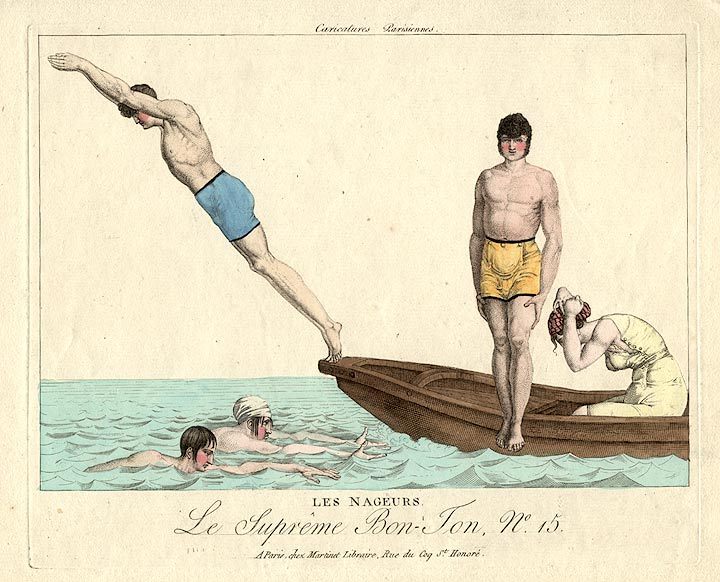How Racism Kept The World’s Fastest Swim Stroke Out Of The Pool
We’ve known since 1844 that freestyle is a superior stroke.

Swimming at the 1904 Olympics. (Photo: Public domain)

On April 20, 1844, two men from North America jumped into the Bath in High Holborn, a 130-foot pool in London. They were there to show how fast they could go.
The British Swimming Society had invited the two men, Wenishkaweabee and Sahma, Ojibwe people from Canada, to compete against each other for a silver medal. Both times that the two swimmers raced the length of the pool, Wenishkaweabee won; in the first race, he was seven feet ahead. But the contest between the two men was less significant than the speed with which they both crossed the pool, in under 30 seconds.
Far from being wowed by this very impressive time, though, the British press found the two swimmers’ movements “grotesque.” The Ojibwe men hit the water “violently,” one paper reported, with their arms thrashing, “like the sails of a windmill,” as they “beat downward with their feet.”
The real contest that day was not between the two swimmers, but between their style of swimming—what we now call front crawl, or freestyle—and the breaststroke favored by the British.
There’s no clear beginning to the history of swimming: art going back millennia shows people moving through the water. But from the earliest representations of swimming, there has been a clear contest between two major swimming strokes. Either people are doing a dog-style paddle or the front crawl.
Why haven’t they invented a new swimming stroke yet it’s 2016 and we know so much more about the human body
— jay caspian kang (@jaycaspiankang) August 10, 2016
Today, there are just four competitive swim strokes—breaststroke, front crawl, back stroke, and butterfly. In the past, swimmers sometimes used sidestroke to race, too. Although the breaststroke and front crawl have probably been around since prehistoric times, they are changing as elite athletes and their coaches study how bodies move through the water.
“The breaststroke and the freestyle that you see today are different than 100 years ago,” says George Edelman, a physical therapist, who’s worked with the USA Swimming Sports Medicine and Science Network for 16 years.
Breaststroke, in particular, keeps being refined. The butterfly stroke was originally an innovation in breaststroke, and earlier in the 20th century, breaststroke swimmers tried to spend as much time as possible under the surface of the water, before competitive rules were changed to require the swimmer’s head to poke out of the water periodically. More recently, says Edelman, breaststroke swimmers figured out how to swim higher in the water, reducing drag.
But in essence these strokes have stayed the same. The task of a swimmer is twofold—maximize propulsion forward, minimize drag against the body—and while tweaks in design can improve efficiency on the margins, there are a limited number of ways to send the human body quickly through water.
Just as cars retain more or less the same, most efficient aerodynamic shape, so do swim strokes. Humans’ breaststroke is essentially just a refinement of the basic survival paddle that we learned from animals—it keeps your body moving and your head above water. Front crawl, though, is designed to move fast.

Swimming in the 19th century. (Image: Le Supreme Bon Ton/Public domain)
When using a front crawl stroke, a swimmer constantly has one arm pulling against the water, propelling the body forward. Most of the forward motion comes from that work in the arms, but a freestyle swimmer can kick constantly, too. The swimmer is buoyant on the surface of the water and their body streamlined—limbs and torso stay in one straight line.
Breaststroke, by contrast, is wide. The swimmer’s hips are dropped lower into the water, and the arms move not just forward but out, on a horizontal plane. The kick, too, brings the swimmer’s thighs forwards, increasing the surface area of the body that’s moving against the water. All that adds up to increased drag—and slower movement.
Plus, in an efficient breaststroke, the swimmer is neither constantly pulling nor constantly kicking. “It’s pull, kick, pull, kick,” says Edelman. The nature and mechanics of the stroke make it slower.
One of the earliest depictions of Europeans swimming, found in Greece, shows the breaststroke. But by 500 B.C. or so, artistic images of swimming indicate that Greek people had learned to front crawl. By the 19th century, though, Europeans had lost that skill.
The British were just starting to swim for sport, using the breaststroke, backstroke, and sidestroke, and they were amazed at reports coming from around the world of people in the Americas and the South Pacific moving quickly through the water using an entirely different technique.

Swimming at the 1900 Olympics. (Photo: Public domain)
In 1844, the British were not ready to admit that an “un-European” style of swimming could beat theirs. After the second race between Wenishkaweabee and Sahma, a British competitor, Harold Kenworthy, challenged them to another race, the third in 10 minutes. He won—but probably only because his competitors were tired out.
By the end of the century, the British had learned that the front crawl was faster, although they would only accept the lesson from one of their own. In 1875, a British swimmer named John Arthur Trudgen took the prize for the 100-yard race in a major British swimming competition, using a stroke that combined the arm movements of the front crawl with the frog kick of the breaststroke. He had learned to swim in Brazil, and he combined the speed of the front crawl’s arm movements with the accepted kicking style. His stroke was less “un-European,” and his time to cover 100 yards was 1 minute and 16 seconds.
Today, top freestyle swimmers can cover 100 meters in about 47 seconds. The world record time for the breaststroke, set at the Rio Olympics by the British swimmer Adam Peaty, is 57.13 seconds. The question of which stroke was faster might have been settled all the way back in 1844 if British people were less blinded by their own cultural norms, but now there’s no doubt: if you want to go faster, front crawl.












Follow us on Twitter to get the latest on the world's hidden wonders.
Like us on Facebook to get the latest on the world's hidden wonders.
Follow us on Twitter Like us on Facebook